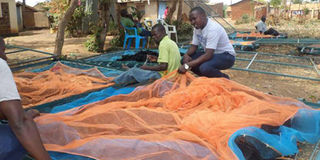Cage aquaculture unlocks new business

Dennis Ayimba with employees making the fish cages in Usenge, Siaya. He sells the cages to farmers in Kisumu, Bondo, Siaya and Busia from Sh60,000 to Sh85,000 depending on size. PHOTO | ELIZABETH OJINA | NATION MEDIA GROUP
What you need to know:
- Dennis Ayimba, 29, fabricates and installs fish cages for farmers in a business that is earning him a fortune.
- The cages consist of metal tubes, wire mesh, cement and sand to make the anchors in water, specialised fish nets, floaters (jerricans) and ropes.
- He sells the cages to farmers in Kisumu, Bondo, Siaya and Busia from Sh60,000 to Sh85,000 depending size. In a good month, the firm sells 20 cages.
- His biggest client is Programme for Agriculture and livelihood in Western Communities (Palweco), a government project in Busia.
Usenge, in Siaya County, is a small but lively town bubbling with several economic activities that include tourism and fish farming.
The latter, done in the nearby Lake Victoria, and now mainly in cages, has brought new tidings in Usenge and other centres bordering the lake.
At one workshop, a young man cuts metal tubes as he works overdrive to meet a client’s order.
Dennis Ayimba, 29, the proprietor of Silver Sky Business Solutions Ltd, is one of the beneficiaries of cage fish farming, a rising practice in the region.
He fabricates and installs fish cages for farmers in a business that is earning him a fortune.
“I design the cages according to a client’s needs and workers assemble them. We then deliver,” says Ayimba, who also manages fish cages for farmers and employs five workers.
“The cages consist of metal tubes, wire mesh, cement and sand to make the anchors in water, specialised fish nets, floaters (jerricans) and ropes.”
For a 2x2m cage, he uses about twenty 20-litre jerricans, which are enough to provide buoyancy and break the waves.
“We fabricate up to 10 cages in a day depending on the type and size. Once the cages are assembled, they are sprayed with water-proof paints and nets fixed after the paint dries. A cage with a depth of 2m takes three nets,” says Ayimba, who studied Environmental Science at Kenyatta University.
STARTING OUT
He sells the cages to farmers in Kisumu, Bondo, Siaya and Busia from Sh60,000 to Sh85,000 depending on size. In a good month, the firm sells 20 cages.
So, how did Ayimba get into the lucrative business?
“In December 2015, I had travelled home for Christmas from Nairobi together with other family members and as we prepared to return to the city where I was working then, we decided to buy fish in plenty. We went in search of it at Anyanga Beach, where cage fish farming is widely practised but didn’t get any because all was booked,” recalls Ayimba.
The scarcity made his family see the opportunity in cage fish farming.
“We teamed up 17 of us, family members and friends, to start the business. We looked for a specialist in aquaculture and ventured into cage fish farming, starting with 25 cages each measuring 2 by 2m and going for Sh50,000. We stocked 2,000 fingerlings in each cage and bought commercial feeds worth Sh500,000 for first three months.”
The business picked up fast, thanks to huge demand for fish.
“The craze for cage fish farming was growing and people got interested in the venture. We invited them to invest with us and we charge them management fees. In all, I manage 170 cages,” he says.
CHALLENGES EXPERIENCED
Ayimba quit his job in Nairobi in September last year to concentrate on running the family business, and his cage fabrication unit that he had started in April.
His biggest client is Programme for Agriculture and livelihood in Western Communities (Palweco), a government project in Busia.
“For Palweco, I saw a tender in the newspaper last year on supply of fish cages and applied. I won it and installed 60 cages in Lake Victoria,” he says, noting the money he made from the business encouraged him to quit his job.
Among challenges in the cage fish farming business is invasion of water hyacinth in the lake.
The Kenya Marine and Fisheries Research Institute Kisumu Director, Dr Christopher Aura, says cage fish farming has good prospects, with 2,500 cages having been installed in the lake.
“There are bays around the lake that are hotspots for water hyacinth such as Kisumu, Nyakach Bay, Asembo Bay, Kendu Bay, Osodo Bay and Homa Bay. Hyacinth takes up a lot of oxygen, reducing the levels of dissolved air in the lake.
It also acts as a hide out for predators such crocodiles, therefore posing a threat to fish,” says Dr Aura.




